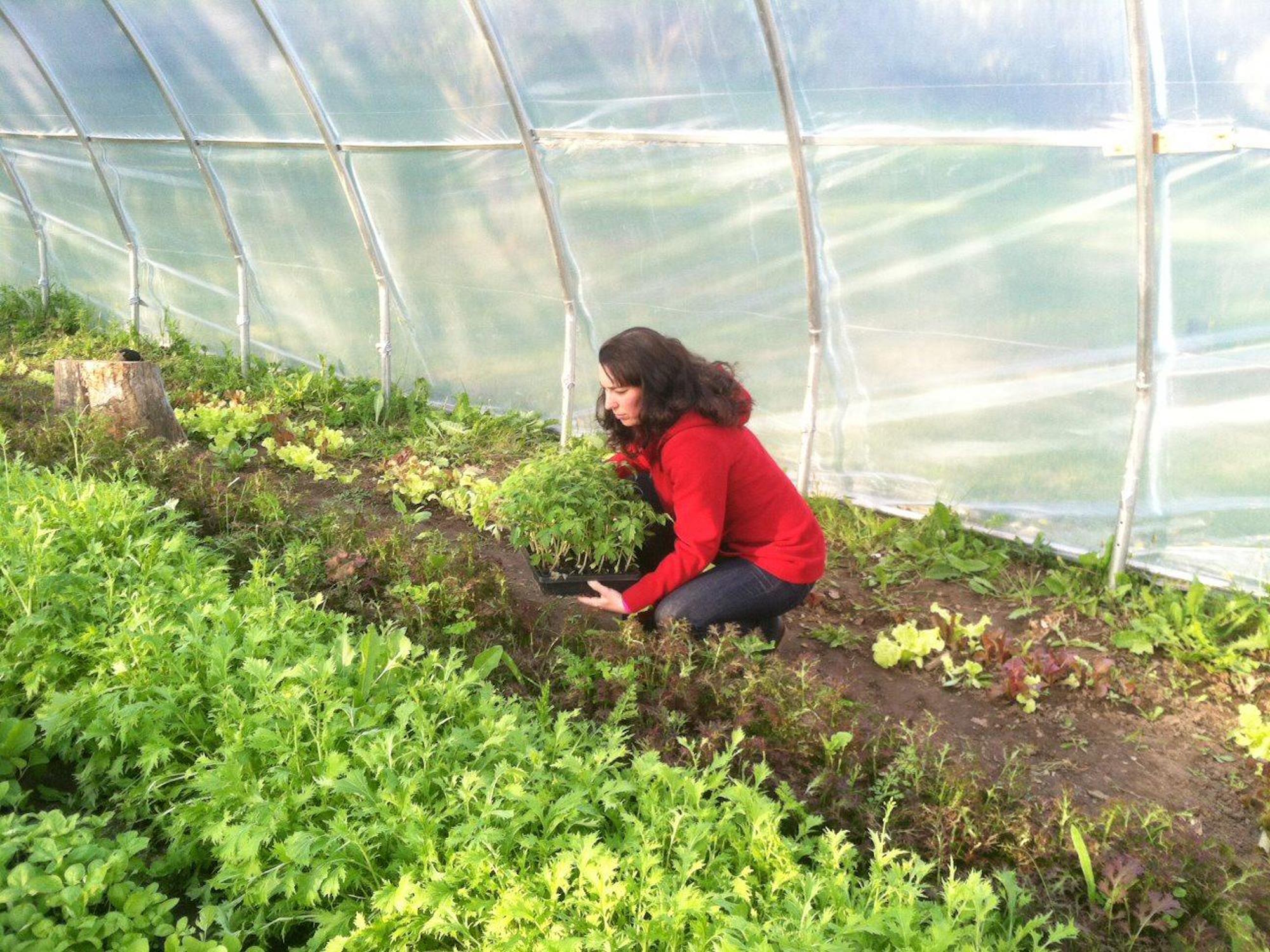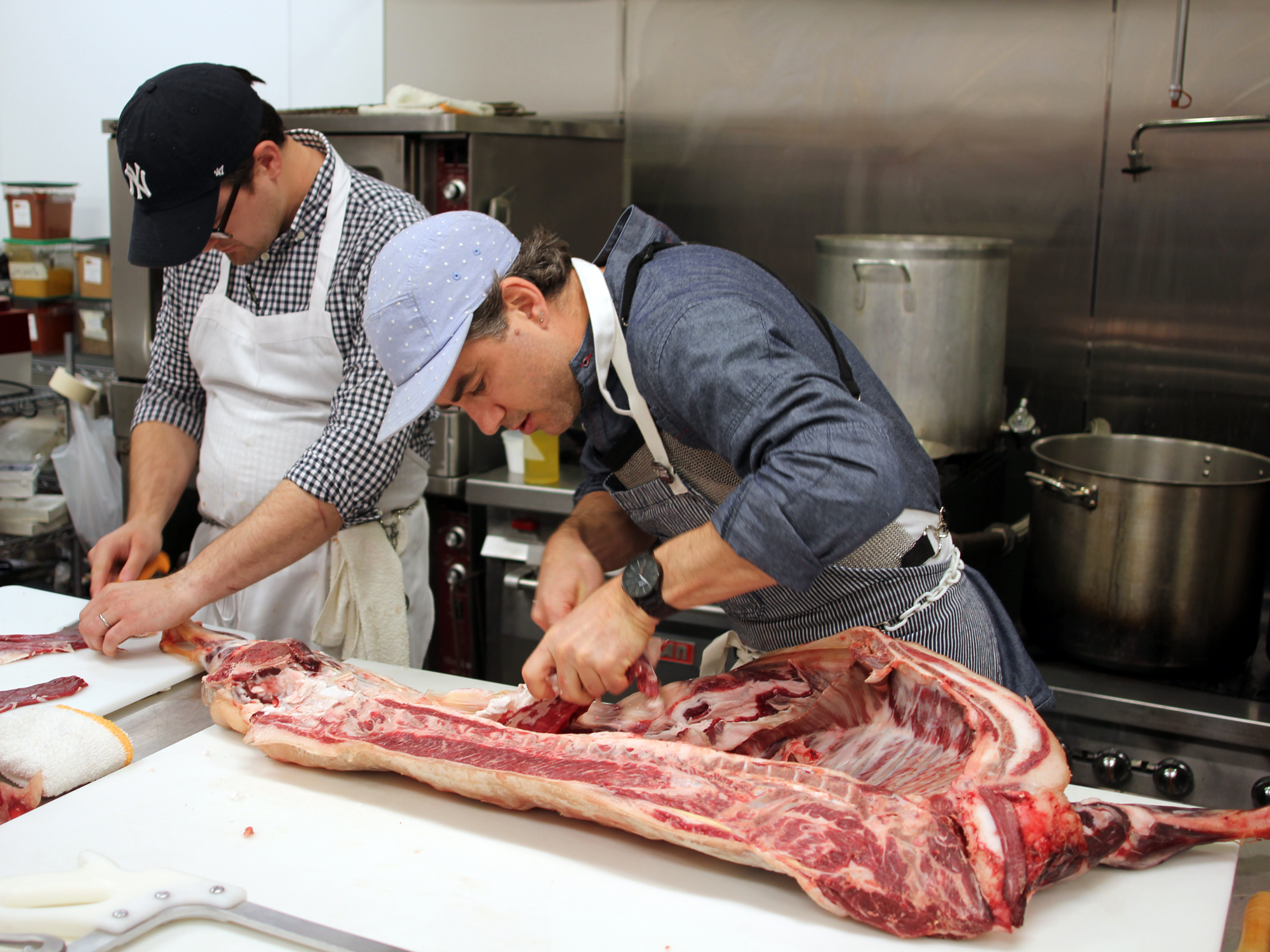THE CURVED HUNK OF PORK HAS ABOUT the ratio of an iceberg—10% is a couple of stripes of meat, 90% is a mountain of white fat. “The spalla is from the shoulder—it is the shoulder,” Rob Levitt of The Butcher and Larder at Local Foods said. “We take off the coppa,” a round roll of meat tucked into pork shoulder which is cured on its own, “and we pull out the bones, and then if you cut around where the brisket is, it has this beautiful sort of teardrop shape. This was from a particularly fatty one,” he said with mild understatement, “but this, shaved and put on top of a pizza last night, was fantastic.”
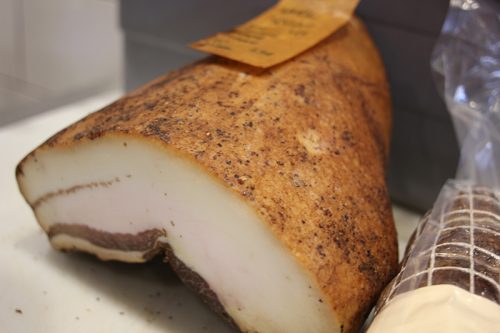
Spalla
He put the spalla on a Berkel slicer and ran off a few ribbons of fat and meat, thin enough to almost see through, and handed me one to taste. Some would have stopped right there—after all, we’re trained in America to have revulsion at fat like this. (He told me later there was some resistance at the pizza event, which was held at Eataly, to covering pizzas in sheer fat, warm enough to be dripping down the sides of the pizzas.)
But in peasant cultures, like Italy’s historically, it was fat like this that kept you alive to do calorie-intensive chores and survive the winter. The butchered hogs of fall became so many different cured meats, developing intense flavors that remain primally satisfying to the peasant parts of our brains that don’t read diet books. I let the ribbon of spalla fall into my mouth and it released deep, complex waves of flavor as it warmed and melted on my tongue—salty meat, and creamy fat, and the hints of seasonings, cinnamon, allspice, coriander, black pepper, mustard, that were rubbed on its exterior.
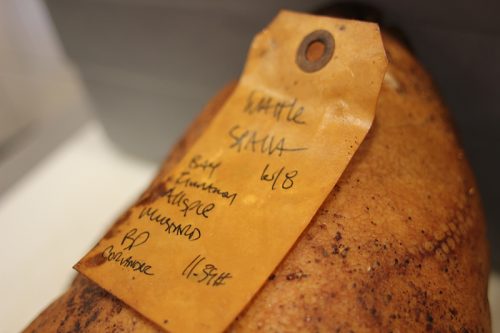
The tag on the spalla shows the recipe and the source—a red wattle pig
I’ve cured meat at home and it’s one of those things, like making bread, where you can get to pretty good relatively quickly and then spend a lifetime finding out what great really means. There’s almost unimaginable richness and profundity to a great piece of cured meat, levels of umami and the funky breakdown of proteins—go ahead, say it, rot—that can only be compared to other things that take a lot of time to release their complexity of flavor, like wine or cheese.
I’d go on like this but Rob quickly had another one for me to taste. It was coppa, from a pig raised by Bare Knuckles Farms, which is co-owned by Abra Berens, who runs the cafe, Stock, at Local Foods. “We cured it, and then we cryovacked it with a good splash of Old Forester bourbon,” he said. “And then we took the spice blend that we made, caraway and allspice and coriander and a little pepper, and we ground it up and mixed it with more of the bourbon and let it dry overnight, then coated the outside with that. And when we slice it, it actually kind of finishes like a glass of bourbon.”

Coppa. from a Bare Knuckle Farms pig
Sure it does… oh wait, it kind of does. We went through other things from the box of parts he’d hauled out. Bresaola, from Carlisle beef, the farm belonging to the father of Milwaukee chef Justin Carlisle. Sobresada, a spreadable salami—”It’s similar to nduja in the way it’s made, but it’s all Spanish, so a lot of smoked paprika.” And then the lonza, which has a relation to another thing behind the counter—a medal, draped over a framed certificate.
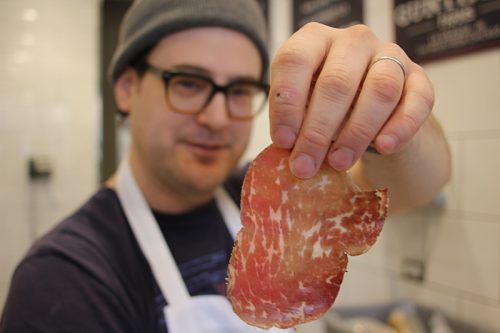
Bresaola
“It has been really fun to cure all these different breeds to see how they come out differently,” Rob said. “Which culminated in, we got a large black from a couple about my age who have this quaint little farm in Michigan. We cured one of the loins, we made lonza, and we submitted it to the Good Food Awards and they selected it as one of their winners. That was a really cool experience, to be able to fly out there and have Alice Waters give me a medal. That’s pretty all right.”
He sliced me a piece of it. After the extravagance of the others, this seemed like minimalism—a pure expression of their skill at curing meat with salt and little if anything else. Which is apparently what the judges thought, too. “So it felt kind of like, we made all this stuff, we’re happy with how it tastes, we feel like we’ve got our system in place, we feel like we’re really ready to ramp it up,” Rob said. “And then [the award] happened, and we said, now we’re going to have our official coming-out party. It was like good timing, because it really gave us the confidence boost we needed to really want to shout it out to the world.”

Lonza and the medal it won
WHAT LEVITT MEANT BY “COMING-OUT PARTY” is an event that will take place on Thursday, March 2nd at Local Foods from 5:30 to 7:30 pm. They’re calling it a “Charcuterie Happy Hour,” and $25 gets you a board of heritage pig charcuterie which is described as “serves 2 generously, 3-5 as a snack.” Rob will do a butchering demo with a Berkshire pig from Triple S Farms, farmer Stan Schutte of Triple S will be there to answer questions about his pigs, and there will be beer and wine for purchase as well as a special cocktail from El Che Bar’s Chris Young.
This debut represents the culmination of a long process, not only of curing meat, but of getting The Butcher and Larder ready to start marketing cured meats of their own. (Up to now they’ve been selling cured meats from existing vendors such as La Quercia and Smoking Goose.) The facility at Local Foods was intended from the start to include a HACCP-certified curing room (visible behind the cafe, Stock), and they were clear to do recipe testing from the start, finally gaining state certification for production about 8 months after they opened. But the workload of the newly opened shop selling fresh meat to customers and restaurant clients got in the way.
“There were times that we had to reprioritize what we were doing in the butcher department, and so some of the curing stuff got put on hold a little bit,” Levitt told me. “We just felt, if we can’t really focus on doing this the right way, then we’re going to wait till we can. We’ve been open for a year and a half and we just felt like that room was just sitting there. Eventually we got to the point where we felt pretty good about dedicating some time and effort to this.”
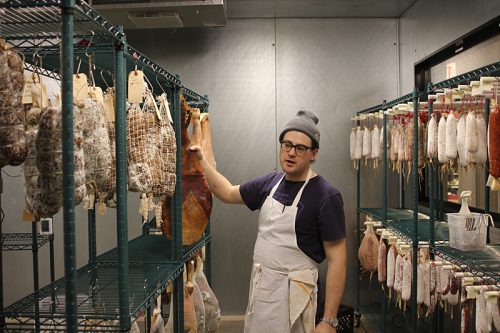
They started in earnest last summer—”We really kind of dug in and started filling that room up. Over the holidays we saved a bunch of product up and sold a ton of charcuterie to people for their holiday parties,” Levitt says.
One thing that ramping up his curing program allowed him to do was to start bringing in more heritage breeds. The meat business runs on uniformity, but charcuterie gives Levitt an outlet to experiment with what farmers are experimenting with. “I have a ton of farmers that reach out to me and they have these interesting things that they’re doing on their farms—unusual breeds, or how they raise the animals. They’re usually small production, and it’s not the kind of thing I can buy week in and week out, but once a month I can go to these guys and say, I want a 200-pound Tamworth, can you bring that to me split [into sides of pork].”
“We’ll sell a certain selection, the loins and other things, for people to cook, and then the rest goes in the room. We’ll take the bellies and we’ll make pancetta, and then we’ll do interesting things that you don’t see very often, like we’ll take the boneless shoulder and make spala, we’ll cure the coppas, we cure the lardo, all the trim becomes salami and then we’ll take the hams and make prosciutto or speck or culatello. It’s really been fun to cure all these different breeds to see how they come out differently,” he said.
The other thing that it enables them to do is to create charcuterie for specific restaurants. I asked him if there was still a market for that, when it seemed like half the restaurants in town were already curing their own. “It hit such a tipping point, but a lot of it wasn’t that great,” he said. “And I think people realized that, just because you can follow the recipe and do everything right, it’s not always going to turn out delicious. I’ve had a lot of chefs tell me yes, they can do it, but they’d rather dedicate their time to training their staff in doing what they’re really good at and get charcuterie from someone like me.” He said he’s talked about collaborating with restaurants making something specific for their menus, like lap cheong, a Chinese sausage, for Fat Rice.
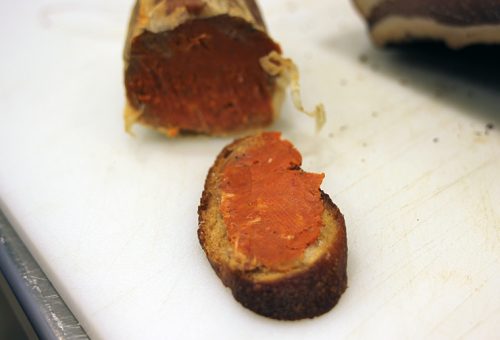
Sobresada, spreadable Spanish salami
One thing he points out that charcuterie isn’t just a thing in itself—many of these items were created to be part of dishes, served with pasta or in a stew. “We sometimes forget that a couple of hundred years ago, people in Calabria weren’t enjoying salumi boards,” Levitt said. “They were trying to survive a cold, hard winter.”
Michael Gebert is umami-rich as editor of Fooditor.
Latest
Join the Discussion
After you comment, click Post. If you're not already logged in you will be asked to log in or register with Disqus.





